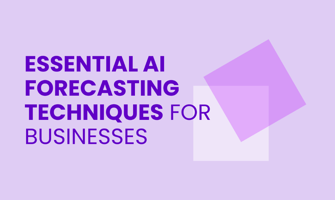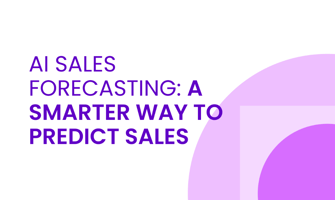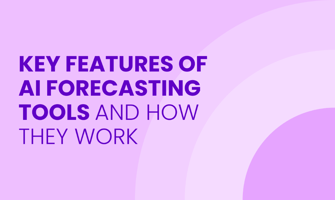Unexpected market changes, shifting customer demands, and financial risks make business planning...
Why Businesses Need AI Forecasting for Better Planning
Planning for the future is hard when so many factors are uncertain. Market shifts, customer behavior, and supply chain issues can throw off even the best strategies. Traditional forecasting methods rely on historical data and assumptions, which can lead to costly mistakes.
AI forecasting changes that. It analyzes large datasets in real-time, spotting patterns humans might overlook. Businesses use it to predict demand, manage inventory, and adjust pricing with greater accuracy. Companies that adopt AI forecasting gain an edge by making faster, data-driven decisions. This article explores how AI forecasting helps businesses plan better and improve product demand forecasting.
Importance of AI Forecasting in Business
AI forecasting plays an important role in improving business planning by turning raw data into actionable insights. Instead of relying on historical trends alone, AI analyzes vast datasets in real time, detecting patterns that traditional methods might miss. This allows businesses to anticipate market shifts, adjust strategies proactively, and allocate resources more efficiently.
By reducing uncertainty, AI improves decision-making at every level. It can identify emerging trends, predict customer demand fluctuations, and highlight risks before they become major issues. This leads to faster, more informed decisions, minimizing wasted inventory, optimizing supply chains, and improving overall operational efficiency.
Businesses that utilize AI forecasting gain a competitive advantage in several ways:
-
Higher accuracy in forecasting reduces costly errors in production and inventory management.
-
Better risk management helps companies prepare for economic shifts, seasonal changes, and unexpected disruptions.
-
Optimized pricing strategies ensure businesses remain competitive while maximizing profit margins.
-
Improved customer satisfaction results from meeting demand more reliably and avoiding stockouts or overproduction.
How AI Improves Demand Forecasting
AI improves demand forecasting accuracy by processing vast amounts of data and detecting patterns that traditional methods often miss. It analyzes historical sales, market trends, and external factors like economic conditions or weather patterns.
Machine learning models then identify correlations and refine predictions over time, improving reliability. This reduces forecasting errors, helping businesses avoid stock shortages or overproduction.
Beyond accuracy, AI-driven automation boosts forecasting efficiency by minimizing manual effort and accelerating analysis. Instead of relying on spreadsheets and static models, AI continuously updates forecasts based on real-time data.
This allows businesses to respond quickly to demand fluctuations, optimize inventory, and streamline supply chain operations. AI-powered platforms like 180ops enhance this process by integrating internal and external data, delivering real-time insights for better decision-making
By combining precision and automation, AI forecasting enables businesses to make informed decisions faster, reducing risks and improving overall planning.
Using AI to Predict Sales Trends
AI-driven forecasting helps businesses stay ahead of market changes by analyzing historical sales data and market trends to predict future demand. By processing large datasets, AI identifies patterns that traditional forecasting methods might miss. This enables businesses to anticipate shifts in consumer behavior and adjust their strategies accordingly.
One major advantage of AI forecasting is its ability to detect changes in consumer preferences. By analyzing real-time data, such as social media trends and online purchasing habits, AI can reveal emerging shifts in demand. Businesses can use this insight to modify product offerings, adjust pricing strategies, or launch targeted marketing campaigns.
Predictive sales trends also play an important role in inventory management and marketing strategies. With accurate demand forecasts, businesses can:
-
Optimize stock levels to avoid overstocking or stockouts.
-
Improve supply chain efficiency by adjusting procurement and production schedules.
-
Enhance marketing efforts by focusing on products expected to perform well.
Practical Applications of AI Forecasting in Business
AI forecasting has transformed how businesses make strategic decisions. It helps companies anticipate future demand, reduce risks, and improve operational efficiency. Many industries use AI-driven forecasting to optimize key processes.
In retail, AI forecasting improves inventory management by predicting demand fluctuations. This reduces stock shortages that lead to lost sales and overstock situations that increase storage costs. By analyzing historical sales data, seasonality, and external factors like economic trends, AI provides retailers with precise demand forecasts. This allows for better stock replenishment and more efficient supply chain coordination.
In financial forecasting, AI models analyze vast amounts of market data to predict investment trends and manage risk exposure. Financial institutions use AI to assess historical price movements, economic indicators, and real-time data to make informed trading decisions. AI forecasting also helps businesses anticipate cash flow fluctuations, enabling better budgeting and financial planning.
In supply chain management, AI forecasting improves logistics planning and reduces operational disruptions. By predicting demand patterns and potential bottlenecks, businesses can optimize transportation routes, allocate resources efficiently, and prevent delivery delays. AI also helps companies adjust to unforeseen disruptions, such as supplier delays or geopolitical risks, by providing real-time recommendations for alternative strategies.
Essential Tools for AI Forecasting
AI-powered forecasting relies on advanced tools to analyze data, identify patterns, and generate accurate predictions. Choosing the right tool is important, as it impacts forecasting accuracy, scalability, and ease of integration into existing business systems.
180ops is an AI-driven forecasting tool that helps businesses optimize revenue operations by integrating internal customer data with external market trends. It utilizes machine learning and advanced analytics to deliver real-time insights, allowing companies to improve sales projections, manage churn risks, and enhance customer engagement.
With features like automated data processing, AI-powered recommendations, and seamless CRM integration, 180ops simplifies complex forecasting, enabling businesses to make faster, data-driven decisions. By using a structured, evidence-based approach, it ensures more accurate demand predictions, helping companies streamline operations and improve financial planning.
Selecting the right AI forecasting tool depends on specific business needs, available data, and forecasting complexity. With its ability to unify data and provide actionable insights, 180ops stands out as an effective solution for businesses seeking precision and efficiency in their forecasting strategies.
Effective Techniques for AI Forecasting
Improving AI forecasting requires applying the right techniques to improve accuracy and adaptability. Three key strategies can help businesses refine their forecasts and make better data-driven decisions.
Ensemble modeling improves accuracy by combining multiple AI models. Instead of relying on a single model, businesses can use different algorithms and aggregate their predictions. This approach reduces errors and accounts for variations in data patterns.
For example, blending decision trees with neural networks can capture both short-term fluctuations and long-term trends.
Feature engineering Improves model performance by selecting and transforming the most relevant data inputs. Businesses should focus on identifying key variables that influence demand, such as seasonality, economic indicators, or promotional activities.
Techniques like normalization, encoding categorical variables, and creating lag features can make AI models more precise.
Real-time data updates keep forecasts accurate by continuously integrating new information. Markets change rapidly, and outdated data can lead to poor predictions. Businesses should implement automated data pipelines that pull live sales figures, customer interactions, and external market conditions. This ensures that AI models adapt to shifting trends and provide reliable forecasts.
Steps to Implement AI Forecasting in Your Business
1. Define Your Business Goals and Forecasting Needs
Start by identifying the specific objectives AI forecasting should support. Common applications include:
-
Demand planning – Predict future customer demand to optimize production and supply chain operations.
-
Inventory optimization – Reduce overstock and stockouts by forecasting product needs more accurately.
-
Financial forecasting – Improve revenue and expense predictions for better budgeting and resource allocation.
-
Workforce planning – Anticipate staffing needs to prevent shortages or excess labor costs.
-
Marketing strategy – Forecast campaign performance and customer engagement trends.
Each objective requires structured, high-quality data to produce reliable forecasts. Ensure that historical data is complete, well-organized, and relevant to the forecasting goal. Poor data quality leads to inaccurate predictions, which can misguide decision-making.
2. Collect and Organize High-Quality Data
To build an effective AI forecasting system, you need high-quality data. The accuracy of your predictions depends on the completeness and reliability of the data you use. Poor data can lead to misleading forecasts, which can negatively impact business decisions.
There are several types of data that are important for AI forecasting:
-
Historical sales data – Past sales figures provide a foundation for predicting future demand patterns.
-
Market trends – External factors such as industry shifts, competitor activity, and economic conditions influence demand.
-
Customer behavior – Purchase history, browsing patterns, and customer preferences help AI models anticipate future buying habits.
-
Seasonal patterns – Identifying recurring fluctuations in demand ensures better inventory and resource planning.
-
Supply chain data – Availability of raw materials and supplier timelines affect production and delivery schedules.
To maximize forecasting accuracy, you have to collect, clean, and organize this data efficiently. Ensure that data sources are consistent and up to date. Remove duplicate, irrelevant, or outdated information that could distort predictions.
Structure the data in a way that aligns with your AI model’s requirements, making it easier to process and analyze.
3. Choose the Right AI Forecasting Model
Selecting the right AI forecasting model depends on the size of your dataset, forecasting complexity, and accuracy requirements.
If you have a large and diverse dataset, deep learning models like recurrent neural networks (RNNs), which analyze sequential data, or transformer-based models, which excel at capturing long-range dependencies, can process complex patterns effectively.
For smaller datasets, traditional statistical models like ARIMA (AutoRegressive Integrated Moving Average), which predicts future values based on past trends, or exponential smoothing, which assigns decreasing weights to older data points, might be more effective.
Consider the complexity of your forecasting needs. Short-term predictions with clear seasonality can be handled with simple machine learning models like decision trees, which split data into structured rules, while long-term forecasting may require advanced architectures like LSTMs (Long Short-Term Memory networks), which retain information over extended periods.
If high accuracy is essential for inventory management or financial planning, ensemble models that combine multiple forecasting techniques can improve reliability by reducing individual model biases.
Additionally, newer models like TimeSeries Dense Encoder (TiDE), which is optimized for speed and scalability, provide faster training and prediction throughout while maintaining high accuracy, making them useful for large-scale business forecasting.
4. Integrate AI Forecasting into Business Operations
Start by embedding AI forecasting into key workflows. This means connecting it with supply chain management, sales planning, and inventory control. When AI-driven forecasts align with these processes, you can make data-driven decisions faster.
For example, if the model predicts a surge in demand, procurement teams can adjust orders in advance to prevent stock shortages.
Ensure that AI forecasting outputs are accessible to relevant teams. This might involve integrating forecasts into dashboards or enterprise resource planning (ERP) systems. Automated reports and alerts help decision-makers respond quickly without manually retrieving data.
To maintain accuracy, continuously refine AI models based on new data. Market conditions change, and AI models have to adapt. Set up periodic reviews to compare forecasts with actual outcomes, adjusting model parameters as needed.
Finally, train employees to interpret AI-driven insights. Even the best AI models are ineffective if teams don’t understand how to use the forecasts. Provide training on how predictions impact daily operations and decision-making.
5. Continuously Monitor and Refine the AI Model
To maintain AI forecasting accuracy, you need to regularly assess its performance. Compare predictions with actual outcomes to identify discrepancies and refine the model. A forecasting model that once performed well might lose accuracy over time because of changes in market conditions, customer behavior, or external factors.
To ensure reliability, focus on these key actions:
-
Track forecast accuracy by measuring error rates such as Mean Absolute Error (MAE) or Root Mean Square Error (RMSE).
-
Analyze deviations between predicted and actual results to spot recurring inaccuracies.
-
Adjust model parameters based on new data to improve predictive performance.
-
Update training data frequently to reflect recent trends and shifts in demand.
-
Test different AI models to see if alternative approaches yield better results.
Refining an AI model is an ongoing process. Regular monitoring helps detect when adjustments are necessary, preventing outdated forecasts from leading to poor business decisions.
Challenges and Considerations in AI Forecasting
AI forecasting offers significant advantages for business planning, but it also comes with challenges that can affect accuracy and reliability. Understanding these challenges helps you make better decisions when implementing AI forecasting in your operations.
Data quality and availability play an important role in forecasting accuracy. AI models rely on historical data to generate predictions, but incomplete, outdated, or biased datasets can lead to unreliable forecasts. Businesses have to ensure their data is accurate, comprehensive, and free from biases that could distort results.
AI forecasting models can also be highly complex, requiring continuous monitoring and adjustments. External factors such as market shifts, economic conditions, or supply chain disruptions can reduce the reliability of predictions.
To maintain accuracy, businesses need to regularly update models, fine-tune parameters, and validate outputs against real-world trends.
Another key consideration is ethical and transparency concerns in AI forecasting. Many AI models function as "black boxes," making it difficult to understand how they arrive at specific predictions. This lack of explainability can be problematic, especially in industries where decisions impact customers or regulatory compliance.
Additionally, biases in training data can lead to skewed forecasts, potentially reinforcing existing disparities in decision-making.
Conclusion
AI forecasting improves business planning by improving accuracy, efficiency, and adaptability. It helps companies anticipate demand, optimize inventory, and make data-driven decisions. As AI models evolve, businesses that embrace this technology will gain a competitive edge. Investing in AI forecasting is a strategic move that leads to smarter planning and sustainable growth.
180ops is an AI-powered revenue intelligence platform that helps businesses improve forecasting by integrating internal customer data with external market trends. It provides real-time insights, enabling companies to optimize sales strategies, reduce churn risks, and enhance decision-making.
Book a demo today to see how 180ops can transform your revenue operations.
FAQ
How Is AI Used in Forecasting?
AI improves forecasting by analyzing large datasets, identifying patterns, and making accurate predictions. It refines forecasts over time, helping businesses optimize inventory, plan demand, and allocate resources efficiently. AI also automates analysis, reducing errors and speeding up decision-making.
Can AI Predict the Future?
Yes, AI predicts trends by analyzing historical data and patterns. Businesses use AI forecasting to improve planning, optimize inventory, and anticipate market changes. It reduces uncertainty, enhances efficiency, and helps companies make informed decisions.
Can AI Do Financial Forecasting?
Yes, AI improves financial forecasting by analyzing data, recognizing trends, and making accurate predictions. It helps businesses reduce risks, allocate resources efficiently, and adapt to market changes with greater precision. AI-driven insights enhance financial stability and decision-making.
What Is the Best AI Forecasting Tool?
The best tool depends on business needs. AI-powered platforms analyze trends, optimize inventory, and improve decision-making. Choosing the right tool depends on data volume, industry, and budget, helping businesses make accurate forecasts and stay competitive.
What Are the Benefits of AI Forecasting Over Traditional Methods?
AI forecasting is faster, more accurate, and adaptable. It processes large datasets in real time, detects complex patterns, and continuously improves. Unlike traditional methods, AI adjusts to market shifts and disruptions, optimizing inventory and reducing costs. Businesses save time, improve decision-making, and stay agile.




